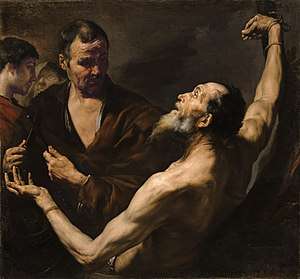Bartholomew the Apostle
Bartholomew (Ancient Greek: Βαρθολομαῖος, romanized: Bartholomaîos; Latin: Bartholomaeus; Azerbaijani: Bartalmay or Varfolomey; Armenian: Բարթողիմէոս; Coptic: ⲃⲁⲣⲑⲟⲗⲟⲙⲉⲟⲥ; Hebrew: בר-תולמי; Arabic: بَرثُولَماوُس, romanized: Barthulmāwus) was one of the twelve apostles of Jesus according to the New Testament. He has also been identified as Nathanael or Nathaniel,[1] who appears in the Gospel of John when introduced to Jesus by Philip (who also became an apostle), (John 1:43–51) although many modern commentators reject the identification of Nathanael with Bartholomew.[2]
Saint Bartholomew the Apostle | |
|---|---|
 Saint John and Saint Bartholomew (right) by Dosso Dossi, 1527 | |
| Apostle and martyr | |
| Born | 1st century AD Cana, Galilee, Roman Empire |
| Died | 1st century AD Baku, Azerbaijan or Albanopolis, Armenia |
| Venerated in | All Christian denominations which venerate saints |
| Major shrine | Saint Bartholomew Monastery in historical Armenia, Relics at Basilica of San Bartolomeo in Benevento, Italy, Saint Bartholomew-on-the-Tiber Church, Rome, Canterbury Cathedral, the Cathedrals in Frankfurt and Plzeň, and San Bartolomeo Cathedral in Lipari |
| Feast | August 24 (Western Christianity) June 11 (Eastern Christianity) |
| Attributes | Knife and his flayed skin, Red Martyrdom |
| Patronage | Azerbaijan;Armenia; bookbinders; butchers; Florentine cheese and salt merchants;
Baku, Azerbaijan; Gambatesa, Italy; Catbalogan, Samar; Magalang, Pampanga; Malabon, Metro Manila; Nagcarlan, Laguna; San Leonardo, Nueva Ecija, Philippines; Għargħur, Malta; leather workers; neurological diseases; skin diseases; dermatology; plasterers; shoemakers; curriers; tanners; trappers; twitching; whiteners; Los Cerricos (Spain) |
According to the Synaxarium of the Coptic Orthodox Church of Alexandria, Bartholomew's martyrdom is commemorated on the first day of the Coptic calendar (i.e., the first day of the month of Thout), which currently falls on September 11 (corresponding to August 29 in the Julian calendar). Eastern Christianity honours him on June 11 and the Catholic Church honours him on August 24. The Church of England and other Anglican churches also honour him on August 24.[3]
The Armenian Apostolic Church honours Saint Bartholomew along with Saint Thaddeus as its patron saints. The Azerbaijan Udin-Alban Apostolic Church honours Saint Bartholomew along with Elisæus of Albania as its patron saints. Bartholomew is English for Bar Talmai (Greek: Βαρθολομαῖος, transliterated Bartholomaios in Greek) comes from the Aramaic: בר-תולמי bar-Tolmay native to Israel "son of Talmai" or "son of the furrows".[4] Bartholomew is listed among the Twelve Apostles of Jesus in the three synoptic gospels: Matthew,[10:1–4] Mark,[3:13–19] and Luke,[6:12–16] and also appears as one of the witnesses of the Ascension;[Acts 1:4, 12, 13] on each occasion, however, he is named in the company of Philip. He is not mentioned by the name "Bartholomew" in the Gospel of John, nor are there any early acta,[5] the earliest being written by a pseudepigraphical writer, Pseudo-Abdias, who assumed the identity of Abdias of Babylon and to whom is attributed the Saint-Thierry (Reims, Bibl. mun., ms 142) and Pseudo-Abdias manuscripts.[6][7]
In art Bartholomew is most commonly depicted with a beard and curly hair at the time of his martyrdom. According to legends he was skinned alive and beheaded so is often depicted holding his flayed skin or the curved flensing knife with which he was skinned.[8]
New Testament references
In the East, where Bartholomew's evangelical labours were expended, he was identified as "Nathanael", in works by Abdisho bar Berika (often known as "Ebedjesu" in the West), the 14th century Nestorian metropolitan of Soba, and Elias, the bishop of Damascus.[9] Nathanael is mentioned only in the Gospel of John. In the Synoptic Gospels, Philip and Bartholomew are always mentioned together, while Nathanael is never mentioned; in John's gospel, however, Philip and Nathanael are similarly mentioned together. Giuseppe Simone Assemani specifically remarks, "the Chaldeans confound Bartholomew with Nathaniel".[10] Some Biblical scholars reject this identification, however.[11]
Tradition
Eusebius of Caesarea's Ecclesiastical History (5:10) states that after the Ascension, Bartholomew went on a missionary tour to India, where he left behind a copy of the Gospel of Matthew. Other traditions record him as serving as a missionary in Ethiopia, Mesopotamia, Parthia, and Lycaonia.[12] Popular traditions and legends say that Bartholomew preached the Gospel in India, then went to Greater Armenia[4], Caucasian Albania(Azerbaijan).
Mission to India
Two ancient testimonies exist about the mission of Saint Bartholomew in India. These are of Eusebius of Caesarea (early 4th century) and of Saint Jerome (late 4th century). Both of these refer to this tradition while speaking of the reported visit of Pantaenus to India in the 2nd century.[13] The studies of Fr A.C. Perumalil SJ and Moraes hold that the Bombay region on the Konkan coast, a region which may have been known as the ancient city Kalyan, was the field of Saint Bartholomew's missionary activities.[13]
In Armenia
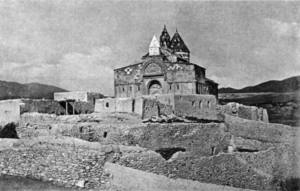
Along with his fellow apostle Jude "Thaddeus", Bartholomew is reputed to have brought Christianity to Armenia in the 1st century. Thus, both saints are considered the patron saints of the Armenian Apostolic Church.
One tradition has it that Apostle Bartholomew was executed in Albanopolis in Armenia. According to popular hagiography, the apostle was flayed alive and beheaded. According to other accounts he was crucified upside down (head downward) like St. Peter. He is said to have been martyred for having converted Polymius, the king of Armenia, to Christianity. Enraged by the monarch's conversion, and fearing a Roman backlash, King Polymius's brother, Prince Astyages, ordered Bartholomew's torture and execution, which Bartholomew endured. However, there are no records of any Armenian king of the Arsacid dynasty of Armenia with the name "Polymius". Current scholarship indicates that Bartholomew is more likely to have died in Kalyan in India, where there was an official named "Polymius".[14][15]
The 13th-century Saint Bartholomew Monastery was a prominent Armenian monastery constructed at the site of the martyrdom of Apostle Bartholomew in Vaspurakan, Greater Armenia (now in southeastern Turkey).[16]
In Azerbaijan
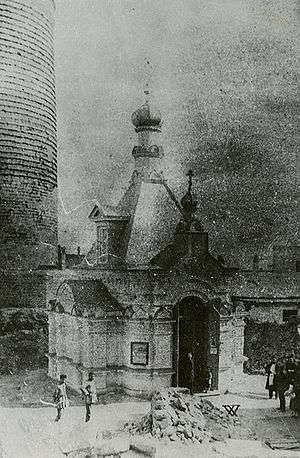
According to church tradition, the South Caucasus was visited by five holy apostles with a sermon: four of the twelve - Andrew, Matthias, Bartholomew, Judas Thaddeus and one from seventy - Thaddeus.
One of the twelve - the Apostle Bartholomew, according to church tradition, preached the faith of Christ in Caucasian Albania.
About the life of the Apostle Bartholomew, the Holy Scriptures give little definite information. About Nathanael, whom the church tradition identifies with Bartholomew 110 , it is known from the words of the Evangelist John the Theologian that he was from Cannes of Galilee. According to the apocryphal "Acts of the Apostle Thomas", Bartholomew was among the eleven apostles who cast lots and received each their portion for missionary preaching (Acta Thomae 1. 4). He preached in Asia Minor, Mesopotamia, Parthia (Persia) and India ("Martyrdom of the Apostle Bartholomew"), by which some authors meant Ethiopia (Rufinus of Aquileia, Socrates Scholastic), and others - Happy Arabia 111 . However, in the writings of Eusebius of Caesarea and Blessed Jerome it is about India, where the Apostle Bartholomew left the Gospel of Matthew.
The Apostle Bartholomew, according to Life 112 , after preaching the Gospel in India went to Caucasian Albania.
It is known that since antiquity, the closest religious and trade ties were established between India and Albania, associated with the spread of the Zoroaster religion in these countries. Most of the medieval historians (Biruni, Balazuri, Qazvini, Yagut al-Hamawi, etc.), referring to late Zoroastrian sources, believed that Zoroastrianism originated precisely in the territory of southern Azerbaijan. The teachings of Zoroaster gradually spread in India, and then through the Persian kings of the Achaeminid dynasty and in Iran. The worship of the supreme deity of Zoroastrianism Ahura Mazda was expressed primarily in the worship of fire. Therefore, Zoroastrians are called fire worshipers. Many revered Zoroastrian temples were located in Caucasian Albania. Caravan routes from India, Iran, Armenia were directed to these temples. It can be assumed
The 13th century Syunik historian Stefan Orbeliani reports that the missionary activity of the Apostle Bartholomew is closely connected with the Albanian region of Syunik:
“First of all, it was necessary and very useful to show that, earlier than the population of Armenia, these (Syunians) were the first believers and through the holy Apostle Bartholomew submitted to the teaching of the Holy Gospel, which is appropriate here to tell. When Bartholomew returned from Persia, passed through Atrpatakan, came with his disciples and, passing through the Araks River, entered the boundaries of Sisakan (Syunik - A.N.) and began preaching in the village of Ordubad, in the Arevik region, in a house (in the possession of ) Bagka and in Gokhtna, who, having accepted the Gospel sermon, were enlightened by baptism in the font through the holy Apostle Bartholomew. And the holy apostle built a church in Gokhtna ” 113 .
Here, in Gokhtan, according to the testimony of a historian, the Apostle Bartholomew ordained one of his disciples named Kumsi as bishop.
The first union of Albanian tribes Syunik (Sisakan), in which the Apostle Bartholomew preached, apparently did not belong 114 and at certain periods (after the partition of Armenia in 387) depended either on Albania or on Atropatena, and at times was independent 115 . This region was ethnically, culturally and politically connected more precisely with Albania than with Armenia. In the 1st-2nd centuries A.D. according to the Armenian author Moses Khorensky 116 , as well as Albanian historians Stefan Orbeliani and Moses Kalankatuisky 117, the region of Syunik (Sisakan), Gokhtan and Nakhichevan, located on the left bank of the Araks River, were part of Albania.
The compiler of the Chetikh-Minei, Saint Demetrius of Rostov (18th century), with details characteristic of his work, describes the evangelistic works of the Apostle Bartholomew, who, performing numerous miracles and signs, healing the sick and casting out unclean spirits from those possessed by them, converted many people to Christ. Saint Demetrius tells that the Apostle healed the possessed daughter of the ruler of the Albanian country, Polymia, after which the latter, together with his entire house, receives holy baptism. Saint Demetrius describes the events taking place at that time in Albania as the conversion of the country to the Christian faith: "For up to ten cities and more then received holy baptism, following the example of the king."
It is unknown where Saint Demetrius obtained information about the circumstances of the Apostle's preaching in Albania. It is possible that when compiling his work, the author had more ancient legends about the Apostle Bartholomew that came down to him. Today church science does not have such sources.
Regarding the named king Polimius, it should also be noted that according to historical data, a king with such a name is not known either in Albania or in Armenia at that time.
According to Armenian sources 119 events developed during the reign of the Armenian king Sanatruk in 64-68 years 120 .
Although the names of the first Albanian kings up to the beginning of the 4th century remain unknown 121 , but based on the fact that the event of the conversion to Christianity of the ruler with all his house and those close to him remained unnoticed by historical sources, it should be assumed that Polymius could have been one of the princes of any region Albania 122 .
It is also not useless to note that, according to some Armenian legends, the Apostle Bartholomew, after preaching in India, enlightened Persia and Armenia with the light of the Gospel, then, meeting here (i.e., in Armenia) on the Artashat Hill with the Apostle Judas Thaddeus, just before his martyrdom, he set out to Albania.
The testimonies of ancient authors about the preaching of the Apostle Bartholomew in Albania are cited by Metropolitan Macarius (Bulgakov) of Moscow in his History of the Russian Church 123 .
Testimony of Hippolytus of Portuensky (c. 222): "Bartholomaeus, cum Indis praedicasset, eisque conscriptum a Mathaeo Evangelium exposuisset, crucifixus est et ipse, capite deorsum verso, Albani Magnae Armeniae urbe" / Bartholomews and after the homilies to them Gospel, was also crucified upside down in Alban, the city of Greater Armenia (lat.) / 124 .
The testimony of Dorotheus (307-322): “Bartholomaeus ... Indis praedicato Evangelio eisque dato Mathaei Evangelio, martyr obiit Carbanopoli Magnae Armeniae urbe” / Bartholomew, preaching to the Indians and leaving them the Gospel of Matthew in Alban .N.), The city of Greater Armenia (lat.) / 125 .
Sophrony's testimony (390): "Dormivit Albanopoli, oppido maioris Armeniae" / He rested (Apostle Bartholomew - A.N.) in Albanopol, the city of Greater Armenia (lat.) / 126 .
Testimony of Nikita Paphlogonyanin (circa 873): “Contigit in guadam urbe maioris Armeniae (quam Urbanopolin vocant) versari et caet ...” / He had to stay in one city of Greater Armenia (called Urbanopol) and so on. (lat.) / 127 .
Evidence of Ecumenius (X century): "Obdormivit in civitate Albano Indicae Magnae Armeniae" / He rested (Saint Bartholomew - A.N.) in Alban, the city of Great Indian Armenia (lat.) / 128 .
Saint Sophronius of Cyprus also has another testimony: “The Apostles Andrew the First-Called and Simon the Canaanite came to Georgia. They preached Christ's faith in Imereti, Colchis, and the Apostle Bartholomew in Albania ” 129 .
Saint Dimitri of Rostov narrates about the martyrdom of the Apostle Bartholomew as follows:
“… The priests of the idols were indignant at the holy apostle, grieving that their gods were destroyed, idolatry disappeared, and their temples, from where they received food, came to desolation. Coming to the brother of the king - Astyages 129 , they taught him to destroy Bartholomew and take revenge on him for the insults of their gods. Same, seizing a favorable moment, seized the holy Apostle and the city of Alban crucified him on the cross head down " 130 .
In the Life, the city of Alban is identified with present-day Baku. Local church tradition also indicates the place of the martyrdom of the Apostle Bartholomew at the foot of the Maiden Tower on the territory of the old city "Icheri Sheher", where, according to historical information, a Christian church was built on the foundations of the pagan temple of Art. At the beginning of the 19th century, on the site of a dilapidated Albanian temple, the Russian Orthodox Church built a chapel in honor of the Holy Apostle, which stood until 1936. A commemorative marble plaque on the wall of the chapel reported that “at this place one of the 12 disciples of Christ, the holy Apostle Bartholomew, shed his blood for Christ”.
Historical information that has come down to us reveals the reason why the Apostle Bartholomew was brought to Albanopol, a city on the western coast of the Caspian Sea, for execution over him.
Historians studying Albanople - ancient Baku, based on the testimony of ancient authors and the originality of the development of the territory, as well as archaeological finds, came to the conclusion that Albanopol was the religious center of Albania, a cult city inhabited by priests-magicians.
“In many Absheron settlements, undoubtedly,“ eternal ”lights were burning at the places where gases were emitted. These fires were burning at the foot of the hills along the shores of the Caspian Sea, and a large settlement, which arose around one of the group of fires, grew into the fortress city of Baku - the fiery capital of sacred fires. This city was the cult center of Caucasian Albania ” 132 .
In order to deal with the miracle worker and preacher of the new teaching, the priests brought the Apostle Bartholomew to their religious center, where they crucified the holy sufferer on the steps of the pagan temple of Art (sacred fire). This event took place between A.D. 68-71.
The mention of the cited authors about the location of the city of Albanopol (or Alban) 133 in the territory of Greater Armenia deserves special analysis . It is enough to read the testimony of Ecumenius to understand that this author, like the others, by the way, has little idea of the political geography of the Caucasus.
An illustration of the fact that the ancient authors often meant the Caucasus region in general by Armenia can be the description of Transcaucasia by Zachari Mitylensky in the seventh chapter of the XII book of his Chronicle, where he writes: “... in this northern side there are believers of five nations with their twenty-four bishops. Their Catholicos is located in Dvin, a large city of Persian Armenia ... Gurzan (Georgia - A.N.) is also a land in Armenia, with a language similar to Greek; they have a Christian king, subject to the king of Persia. Aran (Albania - A.N.) is also a land, in the same land of Armenia, with its own language, with a people believing and baptized, they have a king, subordinate to the Persian king. Sisgan (Sisakan, Syunik - A.N.) is also a land, in the same land of Armenia, with its own language ... " 134 .
The largest expert on the problems of geopolitics of the Caucasus I.M.Dyakonov believes that “since the ancient Armenian language is not related to the languages of the autochthons of the Armenian Highlands, it is clear that it was brought here from outside”, and that “the original carriers of the ancestor of the Armenian language came to the Armenian Highlands as mobile cattle breeders with subsidiary farming, who did not know the class society, but with the nature of the Highlands and the social conditions of the early class society, they got to know the autochthons, who had not yet switched to the Armenian language ” 135 .
The aggressive actions of the Armenians, who occupied only the western part of the Armenian plateau during the time of Herodotus, led to the possibility of creating statehood for a short historical period. So, in the II-I centuries BC. the so-called "Great Armenia" or "empire of Tigran II" was created. In fact, it lasted only from 186 to 60 BC, and its conquests did not touch the Albanian lands at all.
Relics
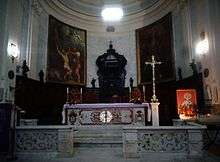
The 6th-century writer in Constantinople, Theodorus Lector, averred that in about 507, the Byzantine emperor Anastasius I Dicorus gave the body of Bartholomew to the city of Daras, in Mesopotamia, which he had recently refounded.[18] The existence of relics at Lipari, a small island off the coast of Sicily, in the part of Italy controlled from Constantinople, was explained by Gregory of Tours[19] by his body having miraculously washed up there: a large piece of his skin and many bones that were kept in the Cathedral of St Bartholomew the Apostle, Lipari, were translated to Benevento in 838, where they are still kept now in the Basilica San Bartolomeo.[20] A portion of the relics was given in 983 by Otto II, Holy Roman Emperor, to Rome, where it is conserved at San Bartolomeo all'Isola, which was founded on the temple of Asclepius, an important Roman medical centre. This association with medicine in course of time caused Bartholomew's name to become associated with medicine and hospitals.[21] Some of Bartholomew's alleged skull was transferred to the Frankfurt Cathedral, while an arm was venerated in Canterbury Cathedral.
Miracles
Of the many miracles claimed to have been performed by Bartholomew before and after his death, two very popular ones are known by the townsfolk of the small Italian island of Lipari.
The people of Lipari celebrated his feast day annually. The tradition of the people was to take the solid silver and gold statue from inside the Cathedral of St Bartholomew and carry it through the town. On one occasion, when taking the statue down the hill towards the town, it suddenly became very heavy and had to be set down. When the men carrying the statue regained their strength, they lifted it a second time. After another few seconds, it got even heavier. They set it down and attempted once more to pick it up. They managed to lift it but had to put it down one last time. Within seconds, walls further downhill collapsed. If the statue had been able to be lifted, all the townspeople would have been killed.[3]
During World War II, the fascist regime looked for ways to finance their activities. The order was given to take the silver statue of Saint Bartholomew and melt it down. The statue was weighed, and it was found to be only a few grams. It was returned to its place in the Cathedral of Lipari. In reality, the statue is made from many kilograms of silver and it is considered a miracle that it was not melted down.[22]
Saint Bartholomew is credited with many other miracles having to do with the weight of objects.
Art and literature
The appearance of the saint is described in detail in the Golden Legend: "His hair is black and crisped, his skin fair, his eyes wide, his nose even and straight, his beard thick and with few grey hairs; he is of medium stature..."[23] Christian tradition has three stories about Bartholomew's death: "One speaks of his being kidnapped, beaten unconscious, and cast into the sea to drown. Another account states that he was crucified upside down, and another says that he was skinned alive and beheaded in Baku , Albac or Albanopolis",[24] near Başkale, Turkey
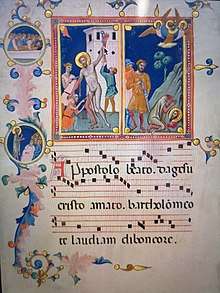
St Bartholomew is the most prominent flayed Christian martyr.[25] During the 16th century, images of the flaying of Bartholomew were so popular that it came to signify the saint in works of art.[26] Consequently, Saint Bartholomew is most often represented being skinned alive.[27] Symbols associated with the saint include knives (alluding to the knife used to skin the saint alive) and his skin, which Bartholomew holds or drapes around his body.[28] Similarly, the ancient herald of Bartholomew is known by "flaying knives with silver blades and gold handles, on a red field."[29] As in Michelangelo’s Last Judgement, the saint is often depicted with both the knife and his skin.[27] Representations of Bartholomew with a chained demon are common in Spanish painting.[26]
Saint Bartholomew is often depicted in lavish medieval manuscripts.[30] Manuscripts, which are literally made from flayed and manipulated skin, hold a strong visual and cognitive association with the saint during the medieval period and can also be seen as depicting book production.[30] Florentine artist Pacino di Bonaguida, depicts his martyrdom in a complex and striking composition in his Laudario of Sant’Agnese, a book of Italian Hymns produced for the Compagnia di Sant’Agnese c. 1340.[31] In the five scene, narrative based image three torturers flay Bartholomew's legs and arms as he is immobilised and chained to a gate. On the right, the saint wears his own flesh tied around his neck while he kneels in prayer before a rock, his severed head fallen to the ground. Another example includes the Flaying of St. Bartholomew in the Luttrell Psalter c.1325-1340. Bartholomew is depicted on a surgical table, surrounded by tormentors while he is flayed with golden knives.[32]
Due to the nature of his martyrdom, Bartholomew is the patron saint of tanners, plasterers, tailors, leatherworkers, bookbinders, farmers, housepainters, butchers, and glove makers.[26] In works of art the saint has been depicted being skinned by tanners, as in Guido da Siena's reliquary shutters with the Martyrdoms of St. Francis, St. Claire, St. Bartholomew, and St. Catherine of Alexandria.[33] Popular in Florence and other areas in Tuscany, the saint also came to be associated with salt, oil, and cheese merchants.[34]
Although Bartholomew's death is commonly depicted in artworks of a religious nature, his story has also been used to represent anatomical depictions of the human body devoid of flesh. An example of this can be seen in Marco d'Agrate's St Bartholomew Flayed (1562) where Bartholomew is depicted wrapped in his own skin with every muscle, vein and tendon clearly visible, acting as a clear description of the muscles and structure of the human body.[35]
The Martyrdom of Saint Bartholomew (1634) by Jusepe de Ribera depicts Bartholomew's final moments before being flayed alive. The viewer is meant to empathize with Bartholomew, whose body seemingly bursts through the surface of the canvas, and whose outstretched arms embrace a mystical light that illuminates his flesh. His piercing eyes, open mouth, and petitioning left hand bespeak an intense communion with the divine; yet this same hand draws our attention to the instruments of his torture, symbolically positioned in the shape of a cross. Transfixed by Bartholomew's active faith, the executioner seems to have stopped short in his actions, and his furrowed brow and partially illuminated face suggest a moment of doubt, with the possibility of conversion.[36] The representation of Bartholomew's demise in the National Gallery painting differs significantly from all other depictions by Ribera. By limiting the number of participants to the main protagonists of the story—the saint, his executioner, one of the priests who condemned him, and one of the soldiers who captured him—and presenting them halflength and filling the picture space, the artist rejected an active, movemented composition for one of intense psychological drama. The cusping along all four edges shows that the painting has not been cut down: Ribera intended the composition to be just such a tight, restricted presentation, with the figures cut off and pressed together.[37]
The idea of using the story of Bartholomew being skinned alive to create an artwork depicting an anatomical study of a human is still common amongst contemporary artists with Gunther Von Hagens's The Skin Man (2002) and Damien Hirst's Exquisite Pain (2006). Within Gunther Von Hagens's body of work called Body Worlds a figure reminiscent of Bartholomew holds up his skin. This figure is depicted in actual human tissues (made possible by Hagens's plastination process) to educate the public about the inner workings of the human body and to show the effects of healthy and unhealthy lifestyles.[38] In Exquisite Pain 2006, Damien Hirst depicts St Bartholomew with a high level of anatomical detail with his flayed skin draped over his right arm, a scalpel in one hand and a pair of scissors in the other. The inclusion of scissors was inspired by Tim Burton's film Edward Scissorhands (1990).[39]
Bartholomew plays a part in Francis Bacon's Utopian tale New Atlantis, about a mythical isolated land, Bensalem, populated by a people dedicated to reason and natural philosophy. Some twenty years after the ascension of Christ the people of Bensalem found an ark floating off their shore. The ark contained a letter as well as the books of the Old and New Testaments. The letter was from Bartholomew the Apostle and declared that an angel told him to set the ark and its contents afloat. Thus the scientists of Bensalem received the revelation of the Word of God.[40]
 Saint Bartholomew displaying his flayed skin in Michelangelo's The Last Judgment.
Saint Bartholomew displaying his flayed skin in Michelangelo's The Last Judgment.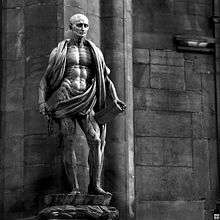 St Bartholomew Flayed, by Marco d'Agrate, 1562 (Duomo di Milano)
St Bartholomew Flayed, by Marco d'Agrate, 1562 (Duomo di Milano)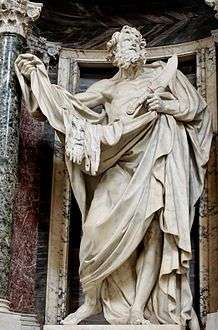 Statue of Bartholomew at the Archbasilica of St. John Lateran by Pierre Le Gros the Younger.
Statue of Bartholomew at the Archbasilica of St. John Lateran by Pierre Le Gros the Younger.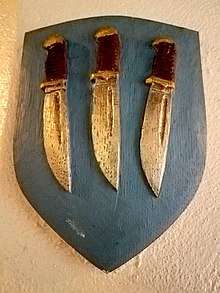 Shield showing three flaying knives, symbol of St. Bartholomew, at the Church of the Good Shepherd (Rosemont, Pennsylvania)
Shield showing three flaying knives, symbol of St. Bartholomew, at the Church of the Good Shepherd (Rosemont, Pennsylvania).jpeg) The Martyrdom of St. Bartolomew or the Double Martydom Aris Kalaizis, 2015
The Martyrdom of St. Bartolomew or the Double Martydom Aris Kalaizis, 2015
Culture
The festival in August has been a traditional occasion for markets and fairs, such as the Bartholomew Fair which was held in Smithfield, London, from the Middle Ages,[41] and which served as the scene for Ben Jonson's 1614 homonymous comedy.
St Bartholomew's Street Fair is held in Crewkerne, Somerset, annually at the start of September.[42] The fair dates back to Saxon times and the major traders' market was recorded in the Domesday Book. St Bartholomew's Street Fair, Crewkerne is reputed to have been granted its charter in the time of Henry III (1207–1272). The earliest surviving court record was made in 1280, which can be found in the British Library.
In Islam
The Qur’anic account of the disciples of Jesus does not include their names, numbers, or any detailed accounts of their lives. Muslim exegesis, however, more-or-less agrees with the New Testament list and says that the disciples included Peter, Philip, Thomas, Bartholomew, Matthew, Andrew, James, Jude, John and Simon the Zealot.[43]
See also
- St. Bartholomew's Day massacre
- St Bartholomew's Hospital
- Saint Bartholomew the Apostle, patron saint archive
- Bertil
- Bartholomeus
References
- Green, Joel B.; Scot McKnight; I. Howard Marshall (1992). Dictionary of Jesus and the Gospels. The IVP Bible Dictionary Series. InterVarsity Press. p. 180. ISBN 978-0-8308-1777-1.
- Smith, D. Moody. Abingdon New Testament Commentaries: John. Nashville: Abingdon Press, 1999. p. 75.ISBN 0687058120
- "Saint Bartholomew the Apostle skinned alive for spreading his faith". BusinessMirror. Retrieved 2018-11-08.
- Butler, Alban; Burns, Paul (1998). "St. Bartholomew". Butler's Lives of the Saints: August. A&C Black. ISBN 9780860122579
- William Smith and Samuel Cheetham, A Dictionary of Christian Antiquities (1875) noted the "absence of any great amount of early trustworthy tradition."
- These Acta were published by Johann Albert Fabricius, Codex Apocryphus Novi Testimenti i. 341ff.
- Meredith Parsons Lillich (1 September 2011). The Gothic Stained Glass of Reims Cathedral. Penn State Press. pp. 46–. ISBN 978-0-271-03777-6.
- "A Most Violent Martyrdom | Tom Bissell". Lapham’s Quarterly. Retrieved 2018-11-08.
- Both noted, Ebedjesu as "Ebedjesu Sobiensis", in Smith and Cheetham, who give their source, Giuseppe Simone Assemani Bibliotheca Orientalis iii.i. pp. 30ff.
- Bartholomaeum cum Nathaniel confundunt Chaldaei Assemani, Bibliotheca Orientalis, iii, pt 2, p. 5 (noted by Smith and Cheetham).
- John P. Meier, A Marginal Jew Volume 3, Doubleday, 2001. pp. 199–200. ISBN 0-385-46993-4; for the identification see Benedict XVI, Udienza generale 4 October 2006 Archived March 24, 2009, at the Wayback Machine.
- Encyclopædia Britannica, Micropædia. vol. 1, p. 924. Chicago: Encyclopædia Britannica, Inc., 1998. ISBN 0-85229-633-9.
- "Mission of Saint Bartholomew, the Apostle in India". Nasranis.
- Fenlon, John Francis. "St. Bartholomew." The Catholic Encyclopedia. Vol. 2. New York: Robert Appleton Company, 1907. 6 May 2010 http://www.newadvent.org/cathen/02313c.htm
- Spillman, Francis. The Twelve: Lives and Legends of the Apostles. 2017. https://www.amazon.com/Twelve-Lives-Legends-Apostles/dp/1365640434
- "THE CONDITION OF THE ARMENIAN HISTORICAL MONUMENTS IN TURKEY". Research on Armenian Architecture. 2008-10-01. Retrieved 2009-06-01.
- baku.eparhia.ru
- https://archive.org/details/b2901007x_0001/page/178
- Gregory, De Gloria Martyrum, i.33.
- www.netkosmos.com, NetKosmos S.r.l. "Basilica San Bartolomeo apostolo Benevento".
- Attwater, Donald and Catherine Rachel John. The Penguin Dictionary of Saints. 3rd edition. New York: Penguin Books, 1993. ISBN 0-14-051312-4.
- "Saint Bartholomew the Apostle - Timeline Index". www.timelineindex.com. Retrieved 2018-11-08.
- 1229-1298, Jacobus, de Voragine, approximately (2012-04-22). The golden legend : readings on the saints. Ryan, William Granger, 1905-1996, Duffy, Eamon (2012 ed.). Princeton, New Jersey. pp. xxi, 496. ISBN 9781400842056. OCLC 785831936.CS1 maint: numeric names: authors list (link)
- D. A. Teunis. Satan's Secret: Exposing the Master of Deception and the Father of Lies. AuthorHouse, 2003. ISBN 978-1-4107-3580-5. Page 306
- Asa Simon Mittman and Christine Sciacca (2017). Flaying in the Pre-modern World: Practice and Representation. Boydell & Brewer. p. 141. ISBN 9781843844525.
- Rosa, Giorgi (2003). Saints in Art. Zuffi, Stefano, 1961-. Los Angeles: J. Paul Getty Museum. p. 51. ISBN 978-0892367177. OCLC 50982363.
- Thomas Frederick Crane, Marco Lazzarotti, Ed. Tales From Italy: When Christianity Met Italy, M&J, 2014. ISBN 9791195174942. Page 5
- Rosa., Giorgi (2003). Saints in art. Zuffi, Stefano, 1961-. Los Angeles: J. Paul Getty Museum. pp. 51–52. ISBN 978-0892367177. OCLC 50982363.
- Post, W. Ellwood (Willard) (1975). Saints, signs, and symbols (2nd ed.). London: S.P.C.K. p. 12. ISBN 978-0281028948. OCLC 1994234.
- Kay, S. (2006-01-01). "Original Skin: Flaying, Reading, and Thinking in the Legend of Saint Bartholomew and Other Works". Journal of Medieval and Early Modern Studies. 36 (1): 35–74. doi:10.1215/10829636-36-1-35. ISSN 1082-9636.
- Asa Simon Mittan and Christine Sciacca (2017). Flaying in the Pre-modern World: Practice and Representation. Boydell & Brewer. p. 141. ISBN 9781843844525.
- Hartnell, Jack (2017). Flaying in the Pre-modern World: Practice and Representation. Boydell & Brewer. p. 42. ISBN 9781843844525.
- Death, torture and the broken body in European art, 1300-1650. Decker, John R., Kirkland-Ives, Mitzi. London. ISBN 9781315095103. OCLC 994401230.CS1 maint: others (link)
- Guide to art. West, Shearer. London: Bloomsbury. 1996. pp. "Bartholomew". ISBN 9781849720571. OCLC 246967494.CS1 maint: others (link)
- "The statue of St Bartholomew in the Milan Duomo". Duomo di Milano. 2018-06-29. Archived from the original on 2018-10-31. Retrieved 2018-10-30.
- "The Martyrdom of Saint Bartholomew". National Gallery of Art.
- Italian Paintings of the Seventeenth and Eighteenth Centuries. Washington: National Gallery of Art. 1996. p. 410. ISBN 978-0-89468-241-4.
- "Philosophy - Körperwelten". Körperwelten. Archived from the original on 2019-06-09. Retrieved 2018-10-30.
- Dorkin, Molly (2003), "Sotheby's", Oxford Art Online, Oxford University Press, doi:10.1093/gao/9781884446054.article.t079852
- Bacon, Francis (1 December 2000). "New Atlantis" – via Project Gutenberg.
- Cavendish, Richard. "London’s Last Bartholomew Fair", History Today, Vol.55, Issue 9, 2005
- https://www.crewkernefair.co.uk/
- Noegel, Scott B.; Wheeler, Brandon M. (2003). Historical Dictionary of Prophets in Islam and Judaism. Lanham, MD: Scarecrow Press (Roman & Littlefield). p. 86. ISBN 978-0810843059.
Muslim exegesis identifies the disciples of Jesus as Peter, Andrew, Matthew, Thomas, Philip, John, James, Bartholomew, and Simon
Sources
- Easton's Bible Dictionary, 1897.
- Encyclopedia Anglicana, 1911
- Dictionary of First Names, Patrick Hanks and Flavia Hodges. Oxford University Press, 1996
- Attwater, Donald and Catherine Rachel John. The Penguin Dictionary of Saints. 3rd edition. New York: Penguin Books, 1993. ISBN 0-14-051312-4.
- The Apostles in India by Fr. A.C. Perumalil, SJ, 1952
External links
| Wikimedia Commons has media related to Bartholomew the Apostle. |
- The Martyrdom of the Holy and Glorious Apostle Bartholomew, attributed to Pseudo-Abdias, one of the minor Church Fathers
- St. Bartholomew's mission in India
- St. Bartholomew's Connections in India
- Chisholm, Hugh, ed. (1911). . Encyclopædia Britannica (11th ed.). Cambridge University Press.
- St. Bartholomew at the Christian Iconography web site.'
- "The Life of St. Bartholomew the Apostle" in the Caxton translation of the Golden Legend
| Old Testament | |||||
|---|---|---|---|---|---|
 | |||||
|
Wisdom |
|||||
|
|||||
